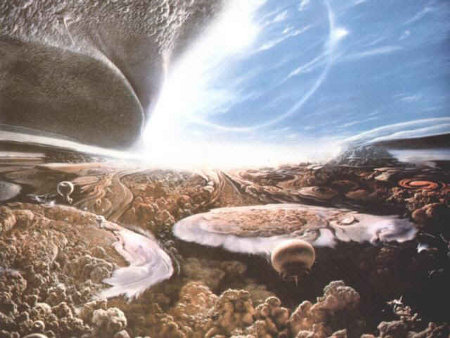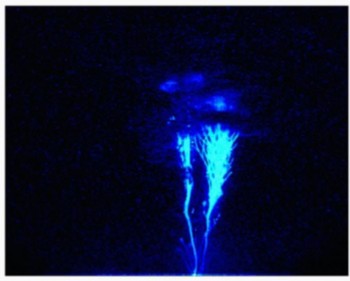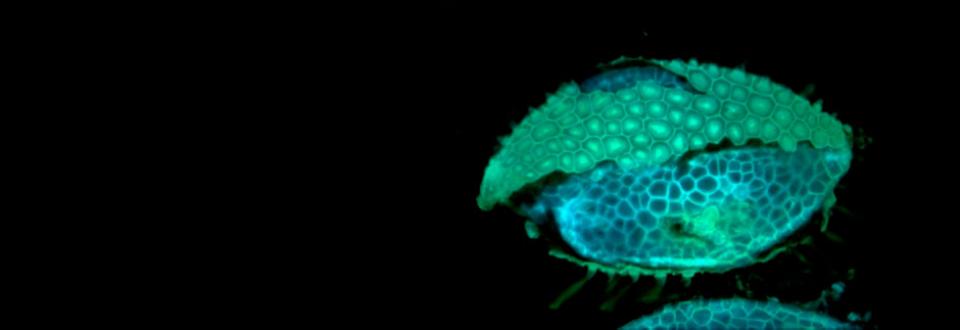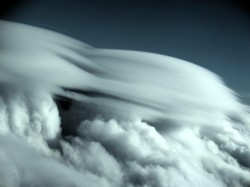Okay, I am NOT talking about Chinese dragons, or giant floating octopusses.

Nor am I referring to upper atmosphere plasma discharges that are confused by some as life forms. Strange and beautiful in their own way, these are an as yet incompletely understood form of lightning. 
I am talking about what David J Smith Refers to as Aerobiology: Microbial life that survives in the upper atmosphere.
From AstroBio.net
Recent studies have confirmed that microbes exist in the stratosphere, the atmospheric region between about 18 and 50 kilometers in altitude. (Baumgartner leaped into history from 39 kilometers up.) Biologists had once thought this zone was uninhabitable due to its low pressure, high radiation and absence of water and nutrients.
“Life surviving at high altitudes challenges our notion of the biosphere boundary,” says David Smith of the University of Washington in Seattle.
Smith is trying to take a more complete census of life in the stratosphere using mountain-top observatories and high-altitude balloons (although he admits being jealous of the lift capacity of Baumgartner’s balloon). With funding from the NASA Astrobiology Institute, he and his colleagues hope to say where these high-flyers come from, where they are going and what their evolutionary trajectory has been.
And as with other Extremophiles, such as those that dwell in total darkness in the deepest parts of the ocean employing chemosynthesis rather than photosynthesis as a base for life, and bacteria that dwell in the boiling water of geothermal vents, or the bacteria that live in the coldest Antarctic climates exchanging a single oxygen molecule for a carbon dioxide over periods of years (effectively taking a single breath and exhaling once) each new place we find life surviving expands the possibilities of finding life in the greater Universe. Even expanding the possibilities of life here in our own solar system. As we come to understand how life survives in these hostile environments we can hope to learn how to prepare ourselves for the exploration of places like Mars or Venus or the outer planets.
Possibly we even give ourselves a heads up in what to look for in a visitor from one of these places.
We also improve our knowledge on the functions of the upper atmosphere and how it influences climate change at the surface, as reported by Nancy Atkinson on Universe Today
A team of atmospheric chemists has moved closer to what’s considered the “holy grail” of climate change science: the first-ever direct detections of biological particles within ice clouds. Ice in Clouds Experiment – Layer Clouds (ICE-L) team mounted a mass spectrometer onto a C-130 aircraft and made a series of high-speed flights through a type of cloud known as a wave cloud. Analysis of the ice crystals revealed that the particles that started their growth were made up almost entirely of either dust or biological material such as bacteria, fungal spores and plant material. While it has long been known that microorganisms become airborne and travel great distances, this study is the first to yield direct data on how they work to influence cloud formation.
Wave clouds. Credit: Andrew HeymsfieldThe team, led by Kimberly Prather and Kerri Pratt of the University of California at San Diego, Scripps Institution of Oceanography, performed in-situ measurements of cloud ice crystal residues and found that half were mineral dust and about a third were made up of inorganic ions mixed with nitrogen, phosphorus and carbon–the signature elements of biological matter.
The second-by-second speed of the analysis allowed the researchers to make distinctions between water droplets and ice particles. Ice nuclei are rarer than droplet nuclei.
The team demonstrated that both dust and biological material indeed form the nuclei of these ice particles, something that previously could only be simulated in laboratory experiments.
“This has really been kind of a holy grail measurement for us,” said Prather.
Even if we just learn to detect microbes by spectrographic analysis it means we can detect life on distant worlds without ever having to visit them, and the presence of upper atmospheric microbes makes them that much easier to detect.
Now for Poetry Corner
The Microbe
by Hilaire BellocThe microbe is so very small
You cannot make him out at all.
But many sanguine people hope
To see him down a microscope.
His jointed tongue that lies beneath
A hundred curious rows of teeth;
His seven tufted tail with lots
Of lovely pink and purple spots
On each of which a pattern stands,
Composed of forty separate bands;
His eyebrows of a tender green;
All these have never yet been seen –
But Scientists, who ought to know,
Assure us they must be so …
Oh! let us never, never doubt
What nobody is sure about!
From More Beasts for Worse Children (1900).
To comment or complain that I said Octopuses in place of Octopi write to:
1 comment






